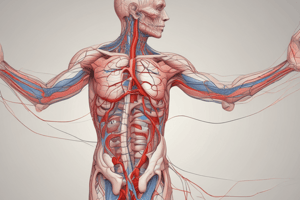Podcast
Questions and Answers
What is the name of the large vein that carries deoxygenated blood from the upper body to the heart?
What is the name of the large vein that carries deoxygenated blood from the upper body to the heart?
- Aorta
- Inferior Vena Cavae
- Pulmonary Veins
- Superior Vena Cavae (correct)
Which chamber of the heart receives blood from the body?
Which chamber of the heart receives blood from the body?
- Left Atrium
- Right Atrium (correct)
- Right Ventricle
- Left Ventricle
What valve is located between the right atrium and right ventricle?
What valve is located between the right atrium and right ventricle?
- Tricuspid Valve (correct)
- Mitral Valve
- Aortic Valve
- Pulmonary Valve
What structure carries oxygenated blood from the lungs to the heart?
What structure carries oxygenated blood from the lungs to the heart?
What is the name of the valve located between the left atrium and left ventricle?
What is the name of the valve located between the left atrium and left ventricle?
What is the primary function of the aorta?
What is the primary function of the aorta?
What is the endocardium?
What is the endocardium?
What is the function of the pericardium?
What is the function of the pericardium?
What is the interventricular septum?
What is the interventricular septum?
What do chordae tendonae do?
What do chordae tendonae do?
What are trabeculae carnae?
What are trabeculae carnae?
What are pectinate muscles?
What are pectinate muscles?
What do moderator bands do?
What do moderator bands do?
What is the fossa ovalis?
What is the fossa ovalis?
What is the pulmonary trunk?
What is the pulmonary trunk?
What is the ligamentum arteriosum?
What is the ligamentum arteriosum?
What is the inferior vena cavae?
What is the inferior vena cavae?
What is the opening of the coronary sinus?
What is the opening of the coronary sinus?
What is the apex of the heart?
What is the apex of the heart?
Flashcards are hidden until you start studying
Study Notes
Major Components of Heart Anatomy
- Superior Vena Cavae: Large vein that carries deoxygenated blood from the upper body to the right atrium.
- Right Atrium: Chamber receiving blood from the superior and inferior vena cavae; initiates pulmonary circulation.
- Tricuspid Valve (right): Valve between the right atrium and right ventricle; prevents backflow during ventricular contraction.
- Right Ventricle: Chamber that pumps deoxygenated blood through the pulmonary valve into the pulmonary arteries.
- Pulmonary Valve: Semilunar valve controlling blood flow from the right ventricle to the pulmonary trunk; responsible for "DUB" sound during heartbeats.
Circulation Pathways
- Pulmonary Veins: Oxygenated blood vessels returning blood from the lungs to the left atrium.
- Left Atrium: Receives oxygen-rich blood from the pulmonary veins; pumps it into the left ventricle.
- Mitral Valve (left): Valve between the left atrium and left ventricle; prevents backflow into the atrium during ventricular contraction.
- Left Ventricle: Thickest chamber; pumps oxygenated blood into the aorta for systemic circulation.
- Aorta: Largest artery in the body; distributes oxygenated blood to the rest of the body.
Valves and Structures
- Pulmonary Valve (semilunar valves; DUB): Functions similarly to the pulmonary valve; also contributes to heart sounds.
- Aortic Valve: Valve that opens into the aorta from the left ventricle; prevents backflow into the ventricle.
- Endocardium: Inner layer of heart tissue lining the chambers and valves; plays a role in heart function.
- Pericardium: Protective sac surrounding the heart; reduces friction during heartbeats.
Septa and Muscle Structures
- Interventricular Septum: Muscular wall separating the right and left ventricles; supports proper flow of blood.
- Papillary Muscles: Muscles attached to chordae tendonae; prevent valve prolapse during ventricular contraction.
- Chordae Tendonae: Tendon-like structures connecting papillary muscles to heart valves; assist in valve function.
- Trabeculae Carneae: Irregular muscular columns found in the ventricular walls; contribute to cardiac contraction.
- Pectinate Muscles: Ridge-like muscular structures in the right atrium; enhance atrial contraction.
Special Features and Vessels
- Moderator Bands: Fibrous bands in the right ventricle; help conduct electrical impulses for coordinated contractions.
- Fossa Ovalis: Depression in the right atrium; remnant of the fetal foremen ovale.
- Pulmonary Trunk: Vessel carrying deoxygenated blood from the right ventricle to the lungs.
- Pulmonary Arteries: Branches of the pulmonary trunk; transport blood to the lungs for oxygenation.
- Ligamentum Arteriosum: Fibrous remnant of the ductus arteriosus; connects pulmonary trunk and aorta; often present in adults.
- Inferior Vena Cavae: Large vein carrying deoxygenated blood from the lower body back to the right atrium.
- Opening of Coronary Sinus: Entry point for cardiac veins into the right atrium; collects blood from heart muscle.
- Apex: The pointed end of the heart; important for the heart's position in the thoracic cavity.
Studying That Suits You
Use AI to generate personalized quizzes and flashcards to suit your learning preferences.



